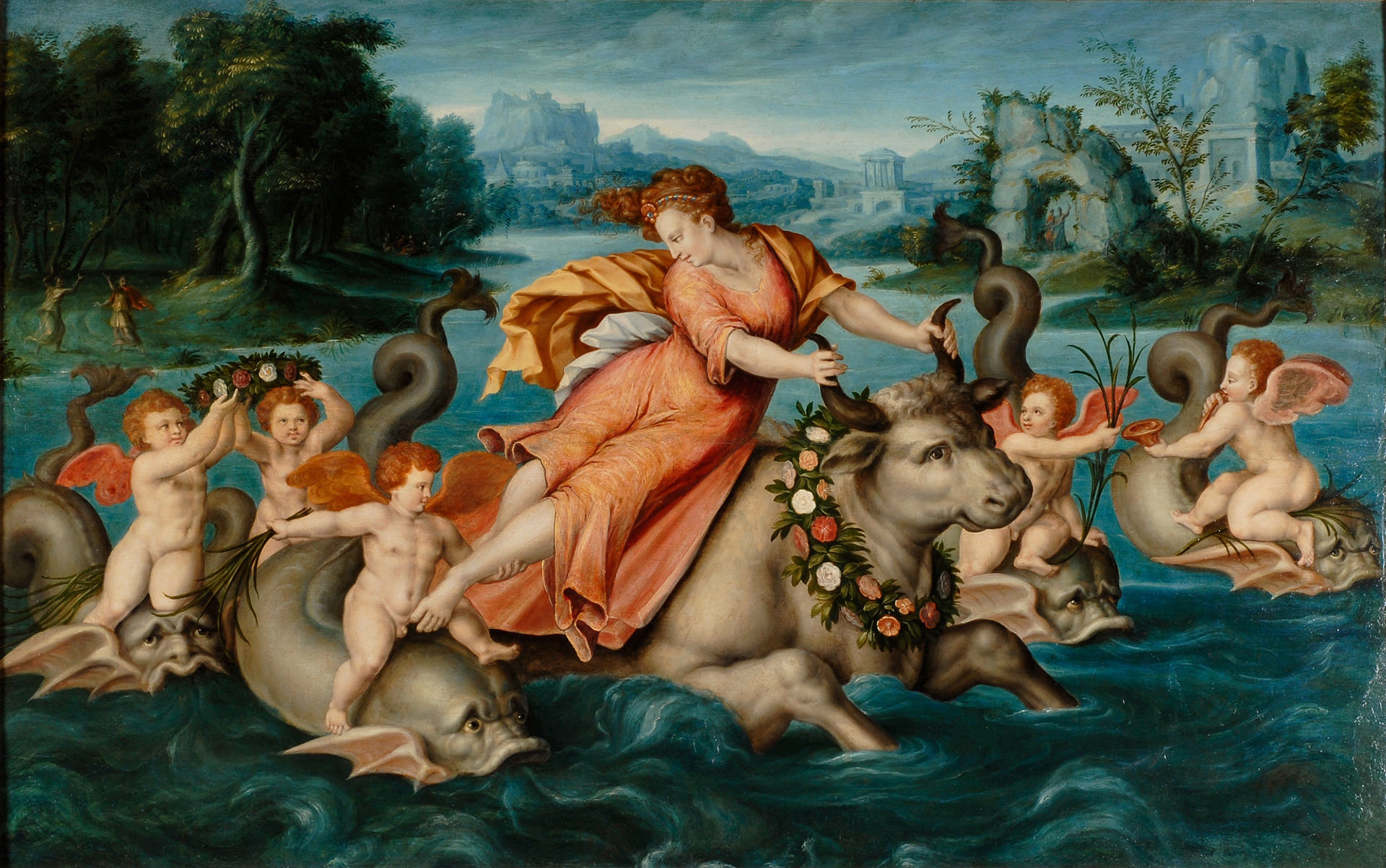
THE COLOR BLUE
by Chloe Destremau
The Color Blue
In the Château of Blois (Loire Valley, France), as I walked through François I’s wing, my eyes were drawn to a sudden splash of blue on the wall. The Abduction of Europa by Jean Cousin the Younger depicts the mythological moment when Zeus, transformed into a bull, carries Europa across the sea. Her flowing orange and gold dress stands out against the blue-green waves.
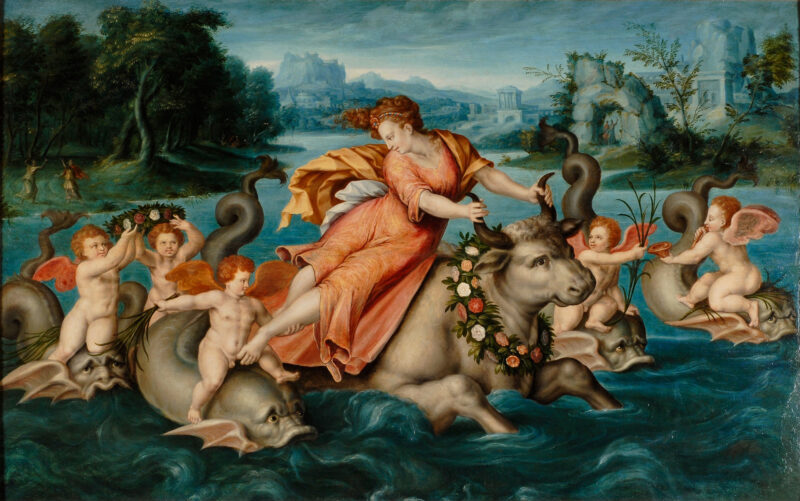
Image above: The Abduction of Europa by Jean Cousin the Younger (c. 1570)
The painting is striking not only for its mythical representation, but also for its use of the color blue. The voice of my 8th-grade art history teacher echoed from my memories: the color blue was the rarest of pigments. As I strolled the corridors and passed painting after painting, each devoid of the blue pigment, my interest in the history of my favorite color sprouted as a seed triggered out of dormancy.
History of Blue Pigment
In the history of color, blue stands out not for its breadth but for its absence. The evolution of the color blue in anthropology is not linear, nor is it landlocked. Across time and continents, human populations have discovered and reinvented blue, using it in ceramics, body paints, dyes, and artwork. Unlike red, black, white, and ochre, derived from an earthy palette that adorned paleolithic caves and neolithic pottery, blue was not present in the earliest human expressions. Its absence was technological: blue pigments were rare and difficult to extract.
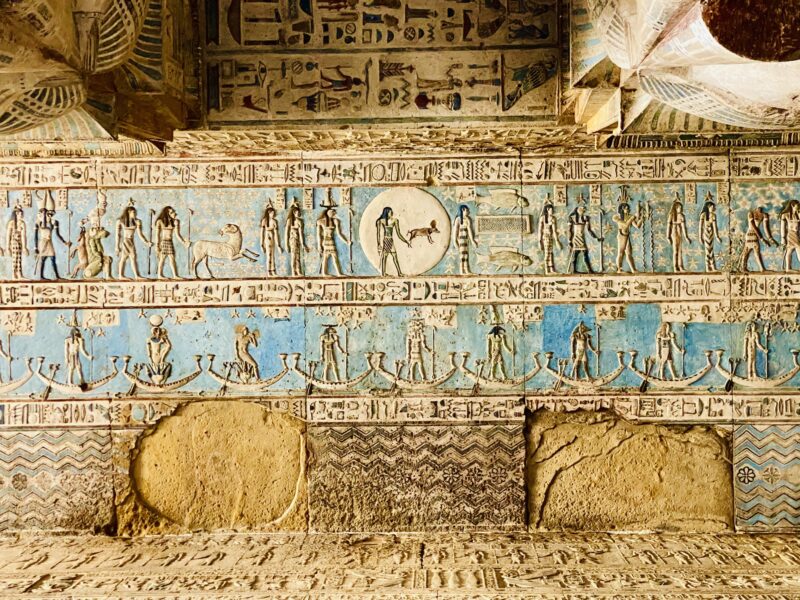
Egyptian Blue
The earliest blue pigment to be synthesized was Egyptian blue, developed in ancient Egypt around 2600 BCE. Created by a mixture of silica, copper, lime, and an alkali, Egyptian blue had a luminous, turquoise hue and was remarkably durable. Egyptians used it extensively for tomb decorations, statues, ceramics, and wall paintings. Egyptian blue remained in use across Egypt until about 500 BCE, its synthesis lost after the empire’s decline.
Image right: The Temple of Hathor at Dendera Complex in Qena, Egypt.
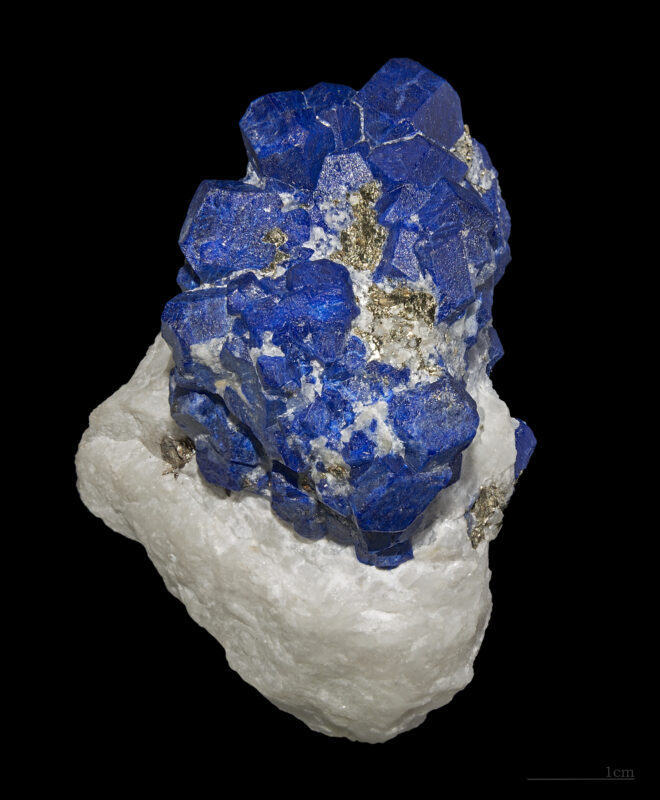
Ultramarine
Parallel to this period, a semi-precious stone called lapis lazuli was being mined from the Sar-e-Sang mines in modern northeastern Afghanistan. The stone itself circulated through trade networks, reaching Mesopotamia, Egypt, the Indus Valley in Pakistan, and central Asia and Persia.
Lapis lazuli reached Europe via Middle Eastern and Persian merchants, but it was not until the 12th century that the technology evolved to extract the stable blue pigment from the stone. Ultramarine, “beyond the sea”, was a stable pigment, intensely blue, and, due to its rarity and laborious process, it was more expensive than gold.
Image left: Lapis lazuli by Didier Descouens, the semi-precious stone from which ultramarine was derived.
Azurite
Due to ultramarine’s scarcity, a cheaper pigment emerged: azurite, a copper-based mineral. It was highly valued from the Middle Ages through the Renaissance due to its deep, vivid hue and accessibility. It was much more abundant and affordable than ultramarine. It was often used as an underpainting, with ultramarine being reserved only for the most critical areas, such as the Virgin Mary’s cloak. However, it was relatively chemically unstable, and over time, it would turn green and even blacken if exposed to the elements.
Many old paintings have morphed into dull greens due to their use of azurite. This is most likely the pigment Jean Cousin the Younger used for The Abduction of Europa; ultramarine would have retained a deeper blue and would have been too expensive to cover half of the canvas.
Synthetic Pigments
From the 1700s onward, synthetic pigments were discovered or actively sought out to counter the cost of ultramarine. Prussian blue was accidentally discovered in 1704, and its easy reproducibility and stability revolutionized blue in painting and in print. Cobalt blue and synthetic ultramarine were developed a century later, and in modern times, many other synthetic blues have been created.
The Evolution of the Perception of Blue
Because of the blue pigment’s difficult obtainability, its perception evolved as it grew in availability.
An Unfavorable Color
The Egyptians assigned a symbolic value to blue, associating it with the divine, the heavens, the Nile, and rebirth. Despite its sacred symbolism, blue was not the most honored color; that belonged to red, gold, and green.
In Rome, blue was associated with barbarians; Celtic and Germanic tribes who stained their body blue and dyed their clothing, leather, and animal skins with woad. Painters thus only used the color blue for secondary elements, such as clothing for enslaved people, non-Roman characters, and backgrounds.
This line of thinking influenced European culture during the High Middle Ages, where blue carried little symbolism and was valued even less than green, the color of vegetation and death. During the Carolingian era, blue was banished from the royal court and worn only by peasants and commoners. Blue remained largely absent from illuminated manuscripts, frescoes, and religious paintings, favoring white (purity), red (power), and purple (imperial status).
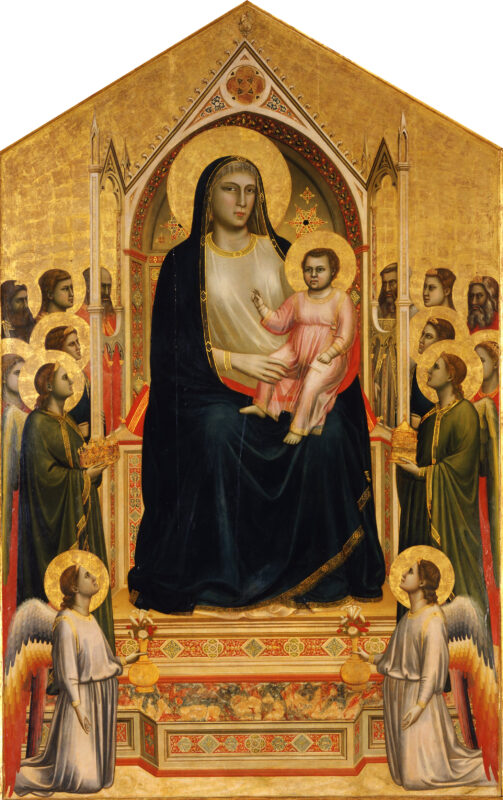
Shift Towards the Divine
However, in the 12th century, blue began a dramatic ascent in symbolic and cultural value. Its turning point was shaped by multiple factors, artistic innovation, advancement in pigment and dye production, and especially in religious imagery. The Virgin Mary became a central figure of devotion to society; she was increasingly depicted wearing deep blue robes, lending divine connotations. Depending on the client’s wealth, ultramarine was used to paint the Virgin Mary’s robe. However, azurite was heavily used as an alternative. Giotto used azurite for the robe depicted in his painting The Madonna and Child.
Blue rose in esteem by the 13th century and became the official color of the French monarchy when Louis IX adopted a blue cloak with golden fleur-de-lis.
Image right: The Madonna and Child Enthroned by Giotto (c. 1310).
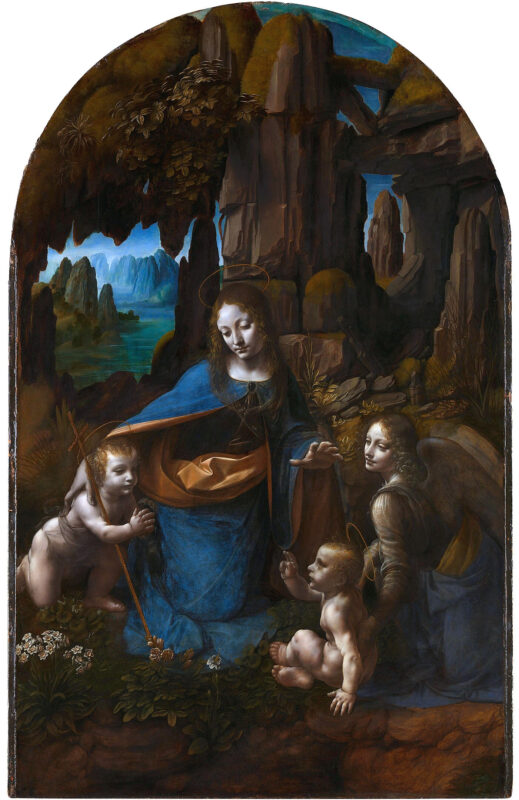
Expansion of Expression
During the Renaissance, blue emerged beyond religious reverence and took on new symbolic and intellectual roles. It was used to create a sense of depth and atmosphere in painting; Leonardo da Vinci used paler hues to create depth and atmosphere in his paintings, such as seen in the Virgin of the Rocks, with the cooler blue mountains in the background. This technique, known as atmospheric perspective, reflected a new understanding of nature, which aligned Renaissance humanism and an interest in scientific perspective.
In the 18th and 19th centuries, the Romantics embraced blue as a melancholic and introspective hue; Goethe described it as evoking infinite longing. It also became the color of the Enlightenment’s virtues: calmness, cleanliness, order. The rise of the modern state, military uniforms, and school systems further institutionalized blue as a color of discipline and respectability.
By the end of the 19th century, blue was no longer tethered to the divine or to social order but utilized to express the artist’s inner world. As seen with The Starry Night by Van Gogh, the turbulent night sky might have reflected both the artist’s inner turmoil and the cosmos as a dynamic entity. His use of ultramarine and cobalt blue in the night sky reflects not only the technical advances in synthetic pigments but also a shift in perception: blue as emotion, as a vessel of the human psyche.
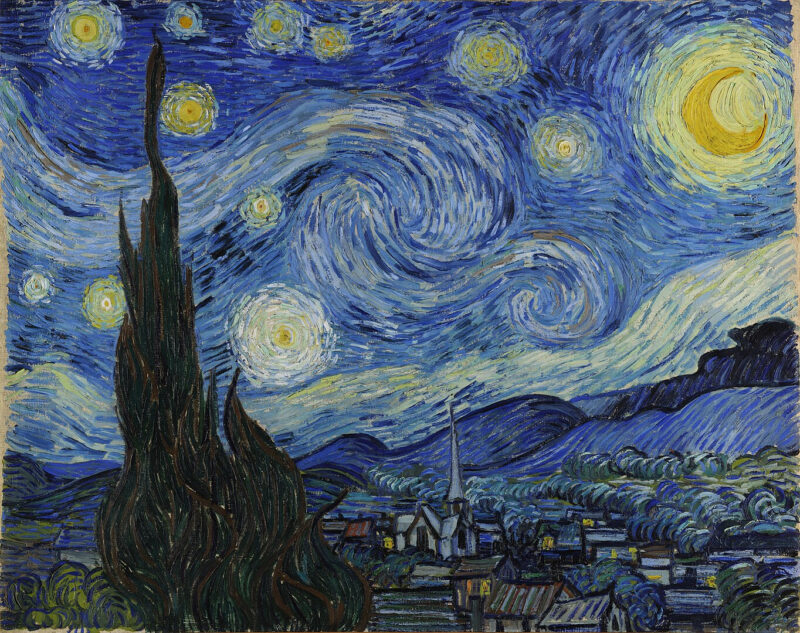
Image above: The Starry Night by Van Gogh (1889)
Today, blue is estimated to be the favorite color of nearly half the population. It is undoubtedly mine, and I use it generously in my own art. This deep dive into the history of the color blue, both as a pigment and as a form of expression, has given me a renewed appreciation for art history and the scientific advancements that made these colors possible. My art history teacher was right: blue used to be the rarest of pigments, ground from precious stones or derived through laborious processes.
I look forward to revisiting the paintings in François I’s wing and the Museum of Fine Arts in Louis XII’s wing at the Château of Blois, as well as travelling to Saint-Rémy-de-Provence to step into Van Gogh’s world through his art.
I’ve focused here on the color blue primarily as a pigment, but its history goes beyond the canvas. In fabric, ceramics, uniforms, and rituals, blue carries for each a different story embodying different meanings, identities, and emotions.

Note about the writer: Chloe Destremau is a freelance writer and the daughter of Christy Destremau, founder and owner of France Off the Beaten Path Tours.
Ready for your journey to discover the enchanting world of France’s past?
- Check out our ALL of our 2026 tour dates.
- Contact us at christy@traveloffthebeatenpath.com to request space availability and/or ask questions.
- Message us on WhatsApp at +1.717.683.2827


